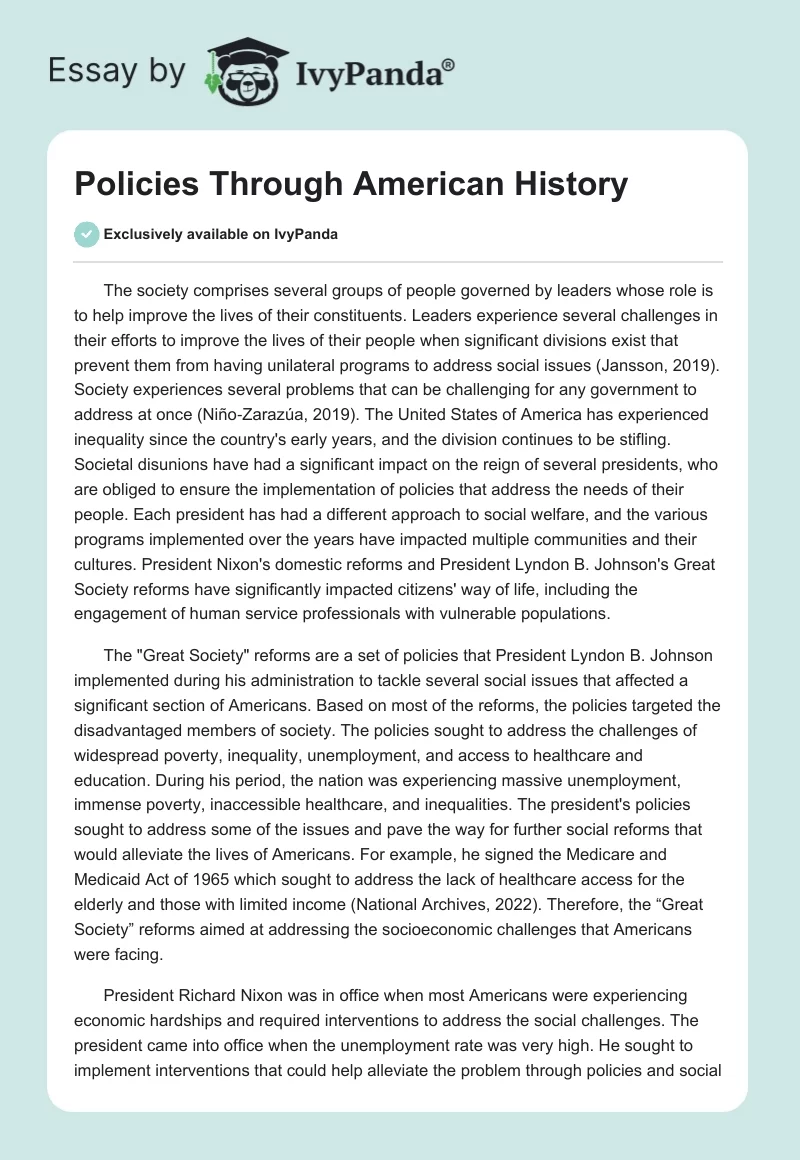The society comprises several groups of people governed by leaders whose role is to help improve the lives of their constituents. Leaders experience several challenges in their efforts to improve the lives of their people when significant divisions exist that prevent them from having unilateral programs to address social issues (Jansson, 2019). Society experiences several problems that can be challenging for any government to address at once (Niño‐Zarazúa, 2019). The United States of America has experienced inequality since the country’s early years, and the division continues to be stifling. Societal disunions have had a significant impact on the reign of several presidents, who are obliged to ensure the implementation of policies that address the needs of their people. Each president has had a different approach to social welfare, and the various programs implemented over the years have impacted multiple communities and their cultures. President Nixon’s domestic reforms and President Lyndon B. Johnson’s Great Society reforms have significantly impacted citizens’ way of life, including the engagement of human service professionals with vulnerable populations.
The “Great Society” reforms are a set of policies that President Lyndon B. Johnson implemented during his administration to tackle several social issues that affected a significant section of Americans. Based on most of the reforms, the policies targeted the disadvantaged members of society. The policies sought to address the challenges of widespread poverty, inequality, unemployment, and access to healthcare and education. During his period, the nation was experiencing massive unemployment, immense poverty, inaccessible healthcare, and inequalities. The president’s policies sought to address some of the issues and pave the way for further social reforms that would alleviate the lives of Americans. For example, he signed the Medicare and Medicaid Act of 1965 which sought to address the lack of healthcare access for the elderly and those with limited income (National Archives, 2022). Therefore, the “Great Society” reforms aimed at addressing the socioeconomic challenges that Americans were facing.
President Richard Nixon was in office when most Americans were experiencing economic hardships and required interventions to address the social challenges. The president came into office when the unemployment rate was very high. He sought to implement interventions that could help alleviate the problem through policies and social welfare programs. The first intervention was adopting an approach of monetary restraint to regulate the economy, which did not work (Zoeller & Bandelj, 2019). Part of the social policies he adopted included the National Health Insurance Partnership Program, which sought to address maintenance issues in healthcare. He oversaw an overhaul of federal welfare programs and introduced a welfare system with negative taxable income. The goal of the new system was to give welfare recipients an incentive and provide the poor with a safety net. The president also worked to expand the food stamp program and proposed the Family Assistance Plan, which would have alleviated the lives of most low-income families. Overall, Nixon intended to address the social issues Americans were facing during the period, with economic challenges being the most significant.
The two presidents’ tenure started when America was experiencing economic and social hardships. They developed social welfare programs designed to address the problems based on approaches they believed to be effective. Both programs identified challenges that were affecting disadvantaged populations. They channeled their efforts to ensure that communities had solutions available. However, comparing the two approaches indicates that President Johnson’s social welfare programs did not target the issues that President Nixon’s policies effectively addressed. Johnson’s approach to providing public members with skills and incentives for employers to recruit more workers is more effective than the government’s overhaul of the social welfare program by Nixon. Therefore, both programs targeted issues experienced by populations, but their effectiveness varies.
The social welfare programs by each president changed the engagement of human service professionals by ensuring that government programs are more targeted to vulnerable populations. The role of human service professionals is to provide community members with services that are not easily accessible, especially in low-income communities (Homer, 2017). They changed this by providing social workers with more integration into the communities they were serving. They also had more knowledge about the communities and the issues that they were experiencing. They had to understand the communities to provide human services effectively. The programs also had a direct approach, where the needs of vulnerable communities got attention to an extent where essential services were available at low or no expense. Through a more focused approach, the two presidents introduced social welfare programs. They improved the engagement of human service professionals with vulnerable communities by making their interventions more divergent on the prevailing issues of the local communities.
Social welfare programs focus on addressing the matters faced by vulnerable members of society. President Johnson and Nixon both adopted social welfare programs based on society’s issues during their rule. The effectiveness of their programs varies based on the problems they address. Both programs are considered efficacious based on the period of execution. Comparably, Johnson’s social welfare approach was more effective because of its targeted approach. However, they both manage to improve the engagement of human services professionals with the local communities through a more integrated approach to social issues.
References
Jansson, B. S. (2019). Social welfare policy and advocacy: Advancing social justice through eight policy sectors (2nd ed.). SAGE Publications.
Homer, C. (2017). Human Services: An essential partner in improving health in the United States. Public Health Reports, 132(2), 127-129.
National Archives. (2022). Medicare and Medicaid act (1965). Web.
Niño-Zarazúa, M. (2019). Welfare and redistributive effects of social assistance in the Global South. Population and Development Review.
Zoeller, C., & Bandelj, N. (2019). Crisis as opportunity: Nixon’s announcement to close the gold window. Socius: Sociological Research for a Dynamic World, 5, 237802311984181.


